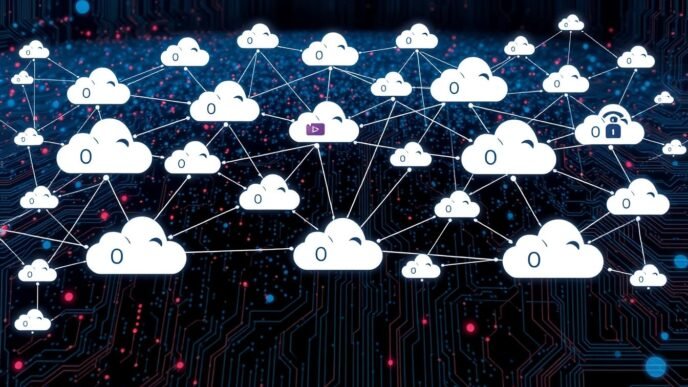The convergence of cloud computing and edge AI is reshaping the landscape of modern technology. As businesses and industries strive to process vast amounts of data in real-time, the cloud computing role in edge AI has become increasingly significant. This synergy between cloud infrastructure and artificial intelligence at the edge is enabling faster decision-making, improved efficiency, and enhanced user experiences across various sectors.
Edge AI, which brings intelligence closer to data sources, is revolutionizing how organizations handle information processing and analysis. By combining the power of cloud-based AI with edge computing, companies can leverage the best of both worlds. This article will explore the impact of cloud computing on edge AI development, the benefits of AI at the edge, and the seamless integration of cloud and edge technologies in AI workflows. Additionally, it will examine real-world edge AI examples and discuss how this technology is shaping the future of AI edge devices and edge servers.
Cloud Computing’s Impact on Edge AI Development

Cloud computing has revolutionized the landscape of AI development, particularly in the realm of Edge AI. By leveraging the power of centralized cloud servers, organizations can now execute complex AI models and algorithms on a large scale, seamlessly integrating with services offered by cloud providers. This synergy between cloud infrastructure and edge computing has paved the way for more efficient, cost-effective, and innovative AI solutions.
Scalability and Resource Allocation
One of the primary advantages of cloud computing in Edge AI development is its ability to offer flexible resource scaling. Cloud platforms provide the agility required to respond to changing market demands and workload requirements. This scalability has an impact on both performance and cost management.
To optimize resource allocation, organizations can implement several strategies:
- Right-Sizing: Selecting appropriate instance types for specific workloads, such as CPU-optimized or memory-optimized instances, helps prevent overprovisioning and minimizes costs.
- Auto-Scaling: Utilizing auto-scaling features enables automatic adjustment of resources, ensuring performance while reducing expenses.
- Managed Services: Opting for managed services that abstract the complexity of the infrastructure minimizes administrative tasks and associated costs.
These practices allow companies to efficiently balance performance and cost, making AI development more accessible across industries and fostering innovation by enabling smaller businesses to participate in AI initiatives.
Data Storage and Processing Capabilities
Cloud computing offers extensive data storage capabilities and high processing power, making it suitable for demanding AI tasks that require significant computational resources and access to vast datasets. This has an impact on how Edge AI systems are developed and deployed.
Cloud AI complements Edge AI by providing greater computational capabilities for training and deploying more intricate and advanced AI models. While Edge AI has limitations on processing capacity due to device size constraints, cloud infrastructure can handle more complex computations and store larger datasets.
The integration of cloud and edge technologies has led to the development of hybrid environments where data processing can occur both locally at the edge and centrally in the cloud. In this model:
- Low-latency applications or those requiring real-time responses handle data processing at edge nodes.
- Aggregated or historical data is sent to the central cloud for further analysis.
This approach optimizes bandwidth usage by filtering, aggregating, and analyzing data locally before transmission to the cloud. For instance, a network of IoT sensors in a smart city can pre-process data at nearby edge nodes, sending only relevant or aggregated information to the cloud.
Cost-Effective AI Model Training

Cloud computing has made AI model training more cost-effective, allowing organizations to maximize their investments and achieve better results with limited resources. However, it’s crucial to understand the cost implications and implement strategies to optimize expenses.
When choosing a cloud provider for AI development, consider the following factors:
- Cost: Understand the provider’s pricing options, including pay-as-you-go, reserved instances, and enterprise-specific pricing. Be aware of potential discounts to significantly decrease costs.
- AI Support: Ensure the provider offers a comprehensive range of AI and machine learning capabilities, including services, toolkits, and pre-built models.
To control costs effectively throughout the development lifecycle, implement these practices:
- Use cost monitoring and reporting tools to track and visualize expenditure.
- Set up budget alerts to notify when spending exceeds specific limits.
- Enforce policies for resource usage to avoid unnecessary expenses.
Real-world examples demonstrate the cost-effectiveness of cloud-based AI development:
- OpenAI’s GPT-3 uses Microsoft Azure’s cloud services to efficiently train its algorithms. By utilizing Azure’s spot instances and implementing model distillation techniques, OpenAI significantly reduces costs without compromising the quality of its AI system.
- GE Healthcare leverages AWS and Google Cloud Platform to develop and deploy AI models for processing medical images, improving the effectiveness of patient treatment while utilizing cloud computing’s capabilities cost-effectively.
As cloud computing continues to evolve, several trends are expected to further enhance its role in Edge AI development:
- Automation of cloud services and management operations will reduce human error and labor expenses.
- Advancements in networking technologies like 5G and faster fiber-optic connections may reduce data transfer costs.
- AI and ML-driven prediction and monitoring of cloud usage trends will enable more precise resource allocation, ensuring organizations only pay for what they use.
By understanding and leveraging these aspects of cloud computing, organizations can significantly impact the development and deployment of Edge AI solutions, making them more accessible, efficient, and cost-effective.
Edge AI: Bringing Intelligence to the Network Edge
Edge AI represents a significant advancement in artificial intelligence, bringing computational power closer to data sources. This approach combines edge computing with AI algorithms, enabling devices to process information locally without relying on cloud infrastructure. By implementing AI at the network edge, organizations can enhance decision-making speed, improve efficiency, and address critical challenges in various industries.
Definition and Key Characteristics
Edge AI refers to the execution of AI algorithms directly on local devices, such as sensors, Internet of Things (IoT) devices, or edge computing hardware. This technology allows for real-time data processing and analysis without constant dependence on cloud connectivity. Edge AI devices utilize embedded algorithms to collect and process data, monitor behavior, and make autonomous decisions.
Key characteristics of Edge AI include:
- Local data processing: Computations occur close to data collection points.
- Real-time analysis: High-performance computing capabilities enable rapid decision-making.
- Reduced latency: Shorter data processing times due to local execution.
- Enhanced privacy: Sensitive data remains on the device, reducing exposure to potential threats.
- Offline capabilities: Devices can continue functioning without network connectivity.
Advantages of Local Data Processing
The implementation of Edge AI offers several advantages over traditional cloud-based AI solutions:
- Improved response times: Edge AI facilitates near-instantaneous feedback, with processing times measured in milliseconds rather than seconds.
- Bandwidth conservation: By processing data locally, Edge AI reduces the amount of information transmitted over networks, preserving internet bandwidth.
- Cost reduction: Edge AI can lower total cost of ownership by minimizing reliance on expensive cloud services for real-time operations.
- Enhanced privacy and security: Local processing reduces the risk of data mishandling and exposure to cyberattacks during transmission.
- Increased availability: Edge AI’s decentralized nature enhances robustness, allowing devices to function during network outages or cyberattacks.
- Continuous improvement: AI models at the edge can learn from new data, becoming more accurate over time.
- Energy efficiency: Local, low-power data processing reduces energy consumption and carbon emissions compared to cloud-based AI solutions.
Use Cases and Applications
Edge AI has found applications across various industries, revolutionizing processes and enabling new capabilities:
- Autonomous Vehicles: Edge AI powers real-time processing of sensor data for object detection, lane tracking, and collision avoidance, enhancing road safety.
- Healthcare: Wearable devices with Edge AI capabilities monitor vital signs, detect anomalies, and enable timely interventions without compromising patient privacy.
- Manufacturing: Edge AI facilitates predictive maintenance, quality control, and process optimization by analyzing sensor data locally on machinery and equipment.
- Retail: In-store Edge AI applications enable inventory management, customer analytics, and personalized shopping experiences.
- Smart Home Devices: Voice assistants and smart appliances utilize Edge AI to respond quickly to user commands and automate tasks.
- Agriculture: Edge AI helps optimize crop yields, monitor soil conditions, and enable precision agriculture techniques.
- Energy Management: Smart grid systems leverage Edge AI to optimize energy distribution, monitor power consumption, and predict equipment failures.
- Security Systems: Edge AI-powered surveillance devices can autonomously detect intruders, analyze behavior, and trigger alarms in real-time.
As Edge AI continues to evolve, its impact on various sectors is expected to grow, enabling more efficient, secure, and intelligent systems at the network edge. This technology promises to reshape how organizations process data and make decisions, paving the way for innovative solutions across industries.
Synergy Between Cloud and Edge in AI Workflows
The integration of cloud computing and edge AI has revolutionized the way organizations process and analyze data. This synergy has an impact on enhancing performance, optimizing data flow, and addressing security concerns. By leveraging the strengths of both cloud and edge technologies, businesses can create more efficient and responsive AI systems.
Hybrid Approaches for Optimal Performance
Hybrid AI approaches combine the power of cloud computing with the speed and efficiency of edge processing. This integration allows organizations to leverage the strengths of both technologies, resulting in improved overall system performance. By utilizing a hybrid approach, companies can:
- Process data locally for real-time decision-making
- Utilize cloud resources for complex computations and model training
- Optimize resource allocation based on specific task requirements
For instance, in a smart city infrastructure, edge devices can handle immediate data processing for traffic management, while cloud systems can analyze long-term trends and optimize city planning.
Data Flow and Model Updates
Efficient data flow and model updates are crucial for maintaining the effectiveness of AI systems. The synergy between cloud and edge computing facilitates seamless data transfer and model optimization. Key aspects of this process include:
- Local data processing: Edge devices handle immediate data analysis, reducing latency and bandwidth usage.
- Selective data transmission: Only relevant or aggregated data is sent to the cloud for further analysis.
- Model updates: Cloud systems can train and refine AI models using aggregated data from multiple edge devices.
- Dynamic model deployment: Updated models can be pushed to edge devices for improved local processing.
This approach enables organizations to maintain up-to-date AI models while minimizing data transfer and optimizing system performance.
Security and Privacy Considerations

As AI systems become more prevalent, ensuring data security and user privacy has become paramount. The integration of cloud and edge computing offers several advantages in this regard:
- Data localization: Edge processing allows sensitive data to remain on local devices, reducing exposure to potential breaches.
- Reduced attack surface: By minimizing data transfer between edge devices and the cloud, the risk of interception is decreased.
- Differential privacy: Edge devices can implement privacy-preserving techniques before sharing data with cloud systems.
- Federated learning: This approach allows model training across multiple edge devices without centralizing sensitive data.
| Security Measure | Description | Benefit |
|---|---|---|
| Data localization | Process sensitive data on edge devices | Reduced risk of data breaches |
| Differential privacy | Add noise to data before sharing | Protect individual privacy |
| Federated learning | Train models across distributed devices | Maintain data confidentiality |
By implementing these security measures, organizations can build trust with users and comply with data protection regulations while still benefiting from the power of AI analytics.
The synergy between cloud and edge computing in AI workflows has an impact on revolutionizing how businesses handle data processing, analysis, and security. By leveraging hybrid approaches, optimizing data flow, and implementing robust security measures, organizations can create more efficient, responsive, and trustworthy AI systems. As this technology continues to evolve, it has an impact on shaping the future of AI applications across various industries, from smart cities to healthcare and beyond
Conclusion
The integration of cloud computing and edge AI has ushered in a new era of technological advancement. This powerful combination has an influence on enhancing data processing capabilities, enabling real-time decision-making, and improving overall system efficiency across various industries. From autonomous vehicles to smart cities, the synergy between cloud and edge technologies is paving the way for innovative solutions that address complex challenges while prioritizing security and privacy concerns.
As we look to the future, the continued evolution of cloud computing and edge AI promises to further transform the technological landscape. This convergence has an impact on shaping the development of more intelligent, responsive, and secure AI systems that can adapt to changing needs and environments. By leveraging the strengths of both cloud and edge computing, organizations are well-positioned to unlock new possibilities and drive innovation in an increasingly connected world.










